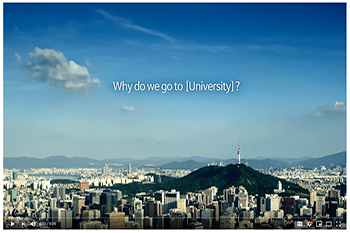
Korean universities are boosting their promotional efforts using YouTube, in a shift to visual media from textual media such as blogs and Facebook. The schools hope to catch the attention of teenagers, who may apply to the university in the near future. According to a survey by Nasmedia, a Korean digital media lab under KT, 69.6 percent of Koreans aged 10 to 19 use YouTube as a search engine, not far behind the percentage of Naver users (89.2 percent), the primary search engine of Korea. Universities have tried to respond to such changes in Internet use, but appear to have struggled to adjust to the new media demands.
Most major Korean universities set up their YouTube channels between 2010 and 2015. Yonsei University set one up in 2014, Korea University in 2013, Ewha Womans University in 2012 and Sungkyunkwan University in 2015. However, the videos uploaded on these channels had not received many views, making them appear ineffective in promoting the schools.
Most initial uploads were recordings of official university events such as retirement ceremonies for professors, graduation ceremonies and alumni days. Such videos had no catchy captions or thumbnails and failed to attract young viewers’ interest. The universities’ footage only began to receive more hits after they started creating contents on university life, introducing different majors and various school activities to boost the schools’ public image, also incorporating better captions. Universities commonly show their facilities in the videos to motivate prospective students to apply to the schools. They also make QnA videos answering frequently asked questions regarding the school. Such video series, which started being uploaded to Yonsei’s official channel since last year, have recorded an average of 50 thousand views per video.
However, the revision of their approach was only after students’ self-made videos which helped to raise their schools’ profiles. Following the success of student-run channels, universities started imitating the themes and style of their contents. Student channels that have attracted young viewers’ attention include Yonko TV, which has been run as a collaboration between Yonsei and Korea University students since 2016. Now with more than 2.5 million subscribers and around 600 videos uploaded on the channel, their videos show snapshots from the daily lives of Yonsei and Korea University students. They started by uploading videos that introduce the life of students of certain majors and now have expanded to videos that give advice on high school studies. More students have since set up channels relating to their schools, creating diverse videos that have caught the interest of teenagers. The popularity and effectiveness of these channels are incomparable to the official channels run by schools, with hardly any of these channels having more than ten thousand subscribers.
One content creator for HYLION, a student-run channel at Hanyang University, pointed out that student’s videos were more appealing because of the freedom retained when making independent contents.
“The independence of our videos seems to be what distinguishes our channel from the official one run by the school,” the student said. “Since we can try out new ideas without any regulations from the school, we have more freedom in the content we create. This makes our contents more powerful than those made by the official channels.”
Attracting more than 16,000 subscribers since it launched in 2018, the HYLION channel has dwarfed Hanyang University’s official YouTube channel, launched in 2013, which has just over 3,400 subscribers. It seems that Korean universities will continue to benefit from student-generated publicity for some time to come.

